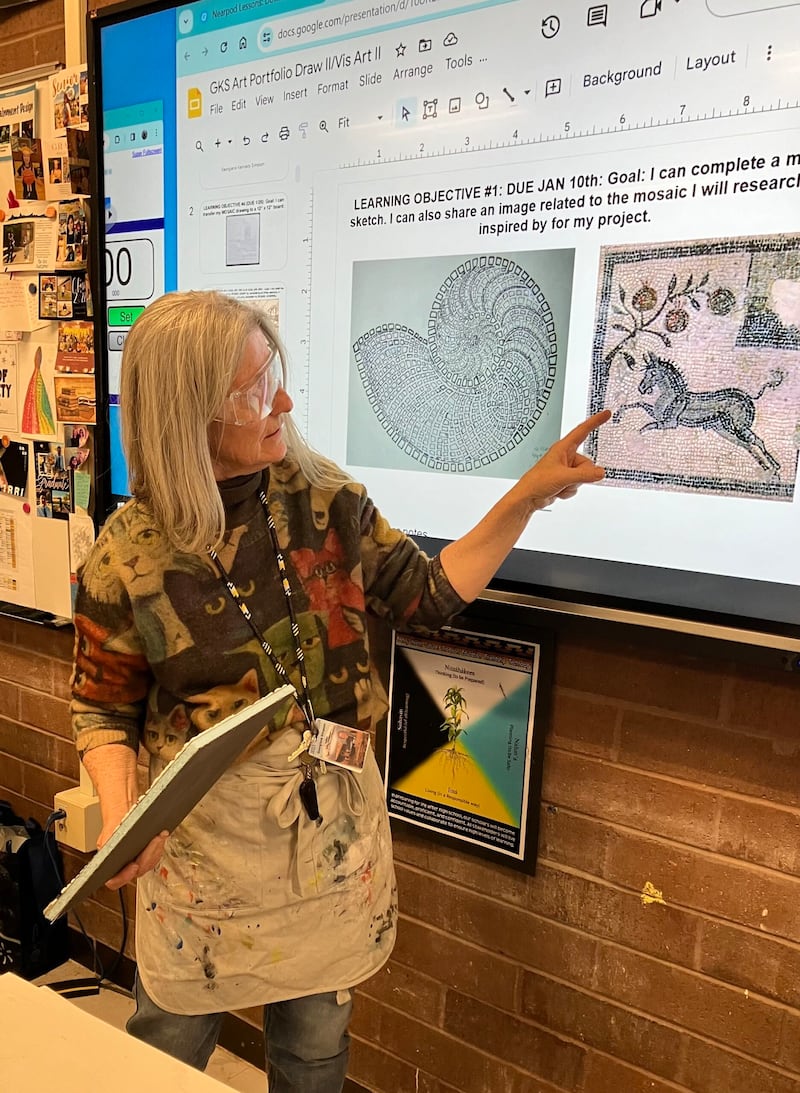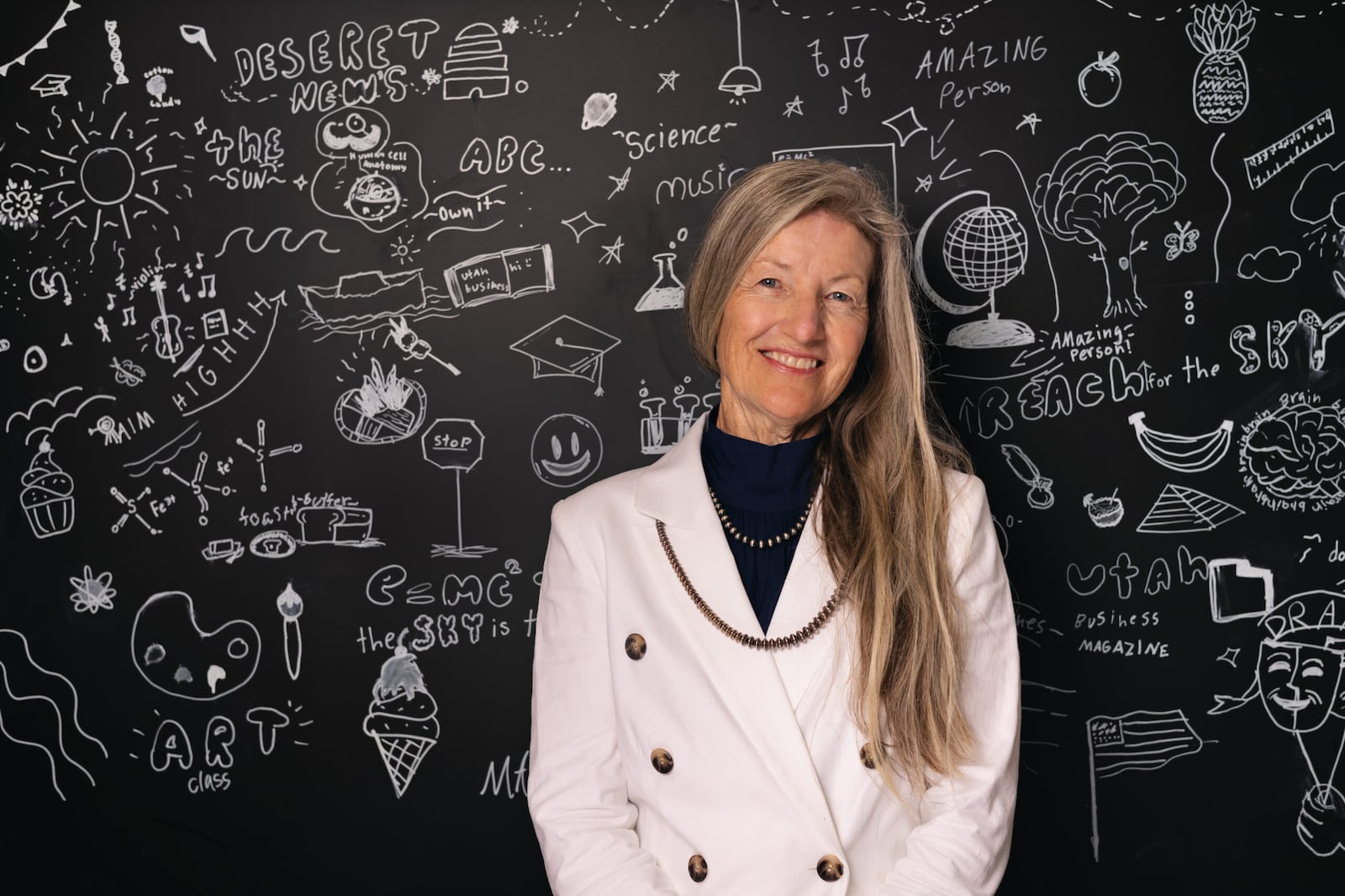Cover photo by MANICPROJECT
Most friendships are the result of happy accidents. The bond that connects Georgiana Simpson and Anna Davis, on the other hand, was premeditated. The bond was forged in an Indianola, Utah, cabin during the annual retreat for Utah Art Educators Association (UAEA) board members, Davis recalls.
“I’d briefly met Georgiana once before and immediately knew she was someone I needed to get to know better. I also knew there were more people than rooms in that cabin, so some of us would need to find roommates. I walked right up and told her she was going to be mine,” Davis remembers, laughing. “We started talking and couldn’t stop.”
The pair had much to share because their stories were so vastly different. Their births are separated by more than two decades. Simpson has long hair she’s allowed to go gracefully gray, while Davis has short hair dyed fiery red. For Davis, the route to a career in arts education was as deliberate and directed as a career path can be, while Simpson practically stumbled into hers at an age when most begin thinking about retirement.
As significant as those differences are, their professional experiences contrast even more.
Davis teaches art at Orem’s Timpanogos High School, in the middle of Utah’s largest school district with a student body that is, according to data compiled by U.S. News & World Report, almost 70 percent white and less than one percent Native American. Nineteen percent of students there qualify for free lunch.
Simpson teaches art at Whitehorse High School in Montezuma Creek, a town of about 300. Whitehorse sits within the borders of the Navajo Nation in one of Utah’s smallest school districts, with a student population that is 98 percent Native American and less than one percent white. Nearly 100 percent of students there qualify for free lunch, and only 30 percent have home internet access, according to Whitehorse Principal Kim Schaefer.
While no school is free of challenges, students at Whitehorse face more than their fair share.
“The vast majority of our kids have trauma-impacted brains, dealing with issues directly connected to their economic circumstances and starting at a very young age,” Simpson says. “When they come to school, there’s often the question of not just whether they’ve had breakfast, but whether they slept with roofs over their heads the night before.”
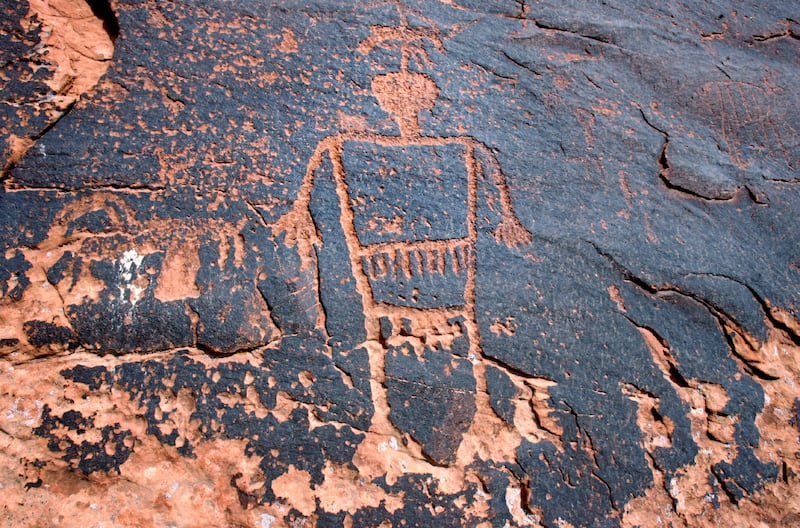
What Simpson and Davis do have in common—and what’s fueled this tight-knit friendship—is a deeply shared commitment to advocate for arts education based on the belief that it elevates a student’s capacity to excel in every other subject.
The winding road to Montezuma Creek
Simpson’s interest in the intersection of artistic expression and Native American culture was kindled by her father, a Native Nations arts trader in Gallup, New Mexico.
“My dad worked with artists in different Native Nations, and I used to love going with him as he gathered rings, rugs and baskets,” Simpson recalls. “It was that experience that eventually brought me back to this part of the world.”
It would take her a while to make that return trip.
“I went to work for a Fortune 500 company in 1983, right out of university. That job took me to the Los Angeles area, but I knew it wasn’t for me,” Simpson says. “I realized it at a retirement party for a colleague when I found myself thinking, ‘I know I don’t want to be here in 30 years.’”
On New Year’s Day in 1990, Simpson left L.A. and returned to the Southwest, where she launched her own Native Nations arts trading business. Ten years later, she established a small arts-focused summer camp for local kids, hoping to make it unlike anything one would expect to find in such a remote area.
“That little camp grew into 100 kids we were hauling in from a 900-square-mile area reaching to the Colorado and Arizona state lines. I still have a hard time thinking about the liability issues we exposed ourselves to,” Simpson laughs. “It was great, but after five years, I felt it wasn’t enough. So, I advocated for an after-school program offering longer and more consistent arts education for local children.”
With that, Simpson became an informal art teacher. Around the same time, she was asked to serve on a board trying to tackle the challenge of providing remote college access to local high school graduates, which was then a much more daunting and expensive problem to solve than it is today. Simpson’s job was oversight of the grant writing process. That experience connected her with the leadership at Whitehorse and planted a seed.
“In 2015, I attended a presentation in Monument Valley on alternate licensure routes for teachers. I was aware of a visual arts position opening up at Whitehorse, and I just knew that was where my path had led. That night, I sat down with my husband and told him what I was going to do next,” Simpson says. She was well into her 50s at the time. “That’s my journey to becoming a professional arts educator, and it’s been a lovely one.”
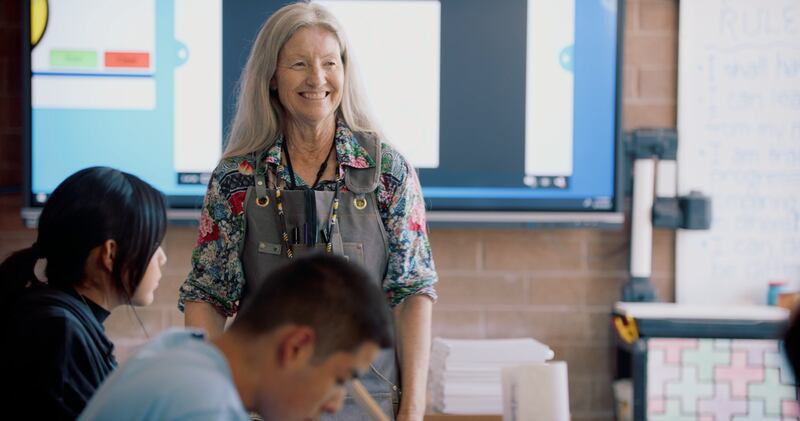
A master of arts in teaching
Seemingly never content to sit still, Simpson then began scanning the horizon in search of the next challenge. The one she settled on was an advanced degree.
“I’d been trying for years to get my master’s, but back then, it was not available to people living in such remote parts of the state,” Simpson says. Little did she know that at the time, Beth Krensky and Kelby McIntyre-Martinez, both professors of art education at the University of Utah (the U), were working to change that.
Krensky left Utah shortly after graduating high school, returning 19 years later. After earning an undergraduate degree in art and two advanced degrees in education while she was away, Krensky aimed to apply all her training by creating a master of teaching fine arts program at the U—a several-year-long process she undertook with the help of McIntyre-Martinez. The pair’s next challenge was to recruit students to fill the inaugural class.
“As soon as Beth realized Georgiana was interested, she got so excited. She looked at me and said, ‘We need her to be a part of this,’” McIntyre-Martinez says. “Georgiana made that first cohort of professional arts educators so strong. Hers was the test group, and the insight she provided was invaluable, particularly when it came to ideas for better accommodating students living in rural areas, which this program specifically intends to accomplish.”
Typically, students pursuing advanced degrees in art take classes dedicated to their medium. Painters study painting with other painters while dancers study dance with other dancers. In contrast, those pursuing a Master of Arts in Teaching at the U are artists of all backgrounds studying education with other educators.
“We ended up with the most beautifully diverse representation of humans in different phases of their careers and lives and art forms all coming together,” McIntyre-Martinez says. “Georgiana’s personality had her constantly saying things like, ‘I never thought of using theater that way; I’m going to do it!’ Then I’d get a long email from her saying, ‘It worked!’”
McIntyre-Martinez says this “yes, and” trait is core to Simpson’s personality and is vital for reaching younger generations.
“Students these days don’t just want to study one art form at a time. They want to combine them and see what happens. Georgiana is all about exploring with them to see what’s possible,” McIntyre-Martinez says. “The way she’s grown, using technology to mix media and film and theater in her classes, is profound. I’m constantly asking her how she pulls it off, and she humbly says, ‘I figured out what I could, and then I’m not above asking my students for help with the rest.’”
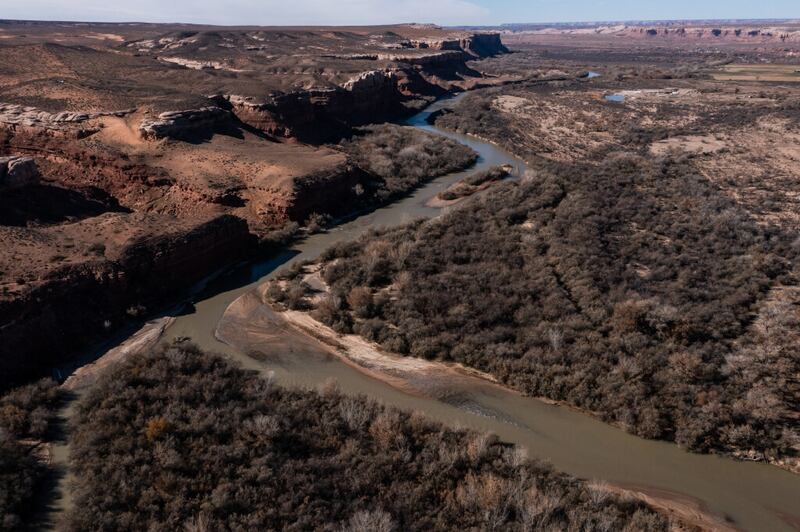
Applied academia
Schaefer feels Simpson’s impact is greatest in her special ability to understand what challenging new academic concepts are being introduced in classrooms down the hall, finding artistic applications presented in ways engineered to lead to the all-important “aha” moment every educator craves.
“The way Georgiana takes her knowledge of art and meshes it with other disciplines or skills accomplishes something so important I can’t say enough about it,” Schaefer says. “For example, in math, they might be learning about proportional relationships, and down in the art room, those same scholars are learning the artistic principles of proportional relationships in perspective by taking images of a certain size and drawing them to a different scale. When students can apply knowledge gained in one domain to another, this not only means more practice but—maybe more importantly—makes the knowledge more relevant. Her ability to creatively do this over and over is astounding.”
Schaefer is quick to concede that she faces stiff headwinds when recruiting teachers to a school as remote and challenging as Whitehorse. She’s grateful that Simpson’s instinct for improving the efficacy of other teachers goes beyond complementing what they’re teaching—it also impacts how they teach.
“We’ve got a reputation for taking whoever is willing to work here and helping them build the skills they need to succeed, and on top of everything else, Georgiana is mentoring two new teachers,” Schaefer says. “Her story and the perspective she brings have improved how we onboard new educators a hundredfold.”
Not long after they bonded in Indianola, Davis invited Simpson to Orem to observe how Alpine School District approaches art education. Given the distance separating them, Davis wondered whether the invitation would be accepted—though only briefly. Davis reports that not only did Simpson immediately commit and make the trek, but she made it at least three times, accompanied by curious colleagues for the final two visits.
In addition to new approaches to pedagogy, one of Simpson’s key takeaways was a determination to advocate for an education experience in the resource-poor San Juan School District that more closely resembles that of resource-rich Alpine.
“Georgiana has a passion for equity. She doesn’t just shrug and say, ‘We don’t have the budget.’ Sometimes the fight for resources seems like more than it’s worth, but not to her,” Davis says. “She believes passionately that every one of her Navajo students deserves an educational experience equal to that of any other kid in Utah. She is doing extraordinary things to benefit that vibrant culture in a remote corner of the state that often goes overlooked, advocating for arts everywhere and elevating education for all educators.”
